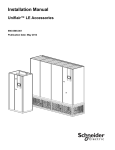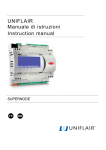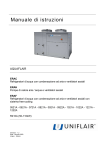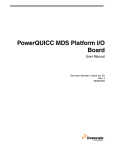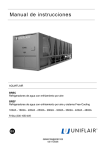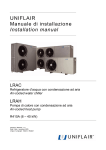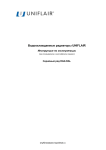Download APC ACAC76128
Transcript
Automatic Floor Pressurization Sensor for Uniflair CW — Installation Overview The Automatic Floor Pressurization Sensor (AFPS) detects a decrease in below-floor air pressure caused by lifted floor tiles or airflow demand created by rack based cooling systems. By modulating fan speed, an AFPS kit for your Uniflair Chilled Water (CW) Unit compensates for these changes in air pressure. The AFPS kit is supported by the following Uniflair CW models: • TDCV0700 • TDCV1000 • TDCV1200 • TDCV1700 • TDCV2500 • TDCV3400 • TDCV4000 • TDCV4300 Safety Notices DANGER HAZARD OF ELECTRIC SHOCK, EXPLOSION, OR ARC FLASH Turn off all power supplying this equipment before working on the equipment. Failure to follow these instructions can result in death or serious injury. WARNING HAZARD FROM MOVING PARTS Keep hands, clothing, and jewelry away from moving parts. Check the equipment for foreign objects before closing the doors and starting the equipment. Failure to follow these instructions can result in death, serious injury, or equipment damage. Inventory na4083a Item Description AFPS controller Power supply harness Above-floor pressure sensor tubing Below-floor pressure sensor tubing Communication wiring Installation hardware tLAN card Mounting bracket Installation Cooling Unit Shutdown 1. From the controller display, put the unit in stand-by and wait for the fans to stop. 2. Turn the disconnect switch to the OFF position. DANGER HAZARD OF ELECTRIC SHOCK, EXPLOSION, OR ARC FLASH Turn off all power supplying this equipment before working on the equipment. All electrical work must be performed by licensed electricians. Practice lockout/tagout procedures. Do not wear jewelry when working with electrical equipment. Failure to follow these instructions will result in death or serious injury. 2 Automatic Floor Pressurization Sensor for Uniflair CW — Installation Attaching the controller box Note: The mounting location of the AFPS controller varies per Uniflair CW unit model. Installation location for AFPS controller Mounting bracket Unit bracket AFPS controller 1. Determine the mounting location on the unit bracket. Align the mounting bracket with the unit bracket, and fasten with a screwdriver. 2. Using a standard screwdriver, remove the front cover and rear tabs from the AFPS controller. 3. Using a Phillips screwdriver, attach the AFPS controller to the mounting bracket using the four screws provided. Automatic Floor Pressurization Sensor for Uniflair CW — Installation 3 Installing the sensors To install the below-floor sensor: 1. Locate the mounting point for the sensor head, and route the tubing through the bottom of the unit and underneath the floor tiles to this location. Note: Avoid placing the positive pressure sensor head under the raised floor where the airflow velocity is high: for example, directly beneath the unit. The recommended position for the pressure sensor head is 3–4 m (10–13 ft) away from the unit. 2. Fasten the mounting clamp to a raised floor post. 3. Ensure that excess tubing is carefully secured. Avoid sharp bends or kinks in the tubing. Sensor head clamps on raised floor post The above-floor pressure sensor can be installed in the port located at the bottom right corner of the Uniflair unit. To install the above-floor pressure sensor to the Uniflair port: 1. Using a standard screwdriver, pry off the cover on the sensor port. 2. Route the tubing through the cooling unit, neatly coiling any excess tubing. 3. From inside the unit, attach the sensor head to the port, then fasten the fitting into the port from outside the unit. 4 Automatic Floor Pressurization Sensor for Uniflair CW — Installation Note: If the unit is not in the air-conditioned room, the tubing can be installed using the wall mounting bracket provided with the kit. To mount the above-floor pressure sensor head to a wall: 1. After determining an appropriate location for the sensor, drill a hole through the wall and mount the sensor bracket. WARNING HAZARD TO EQUIPMENT OR PERSONNEL Verify that the area behind the wall is free of electrical wires or piping before drilling holes into the wall. Failure to follow these instructions can result in death, serious injury, or equipment damage. 2. Route the tubing behind the wall and through the hole, then attach to the sensor. Wall-mounted sensor Note: Ensure that the wall-mounted sensor is installed away from direct airflow. Automatic Floor Pressurization Sensor for Uniflair CW — Installation 5 tLAN connection CAUTION HAZARD TO EQUIPMENT Circuit boards contained within this unit are sensitive to static electricity. Use one or more electrostatic-discharge device while handling the boards. Failure to follow these instructions can result in equipment damage. 1. Using a screwdriver, remove the Analog Selection cover on the controller inside the unit. 2. Cut or pry out the pre-cut plastic section (right-side) from the cover to access the tLAN card slot. 3. Aligning the connector pins, insert the tLAN card into the slot and push into place, making sure the card is pushed all the way up against the two plastic supports on the UPC1 case. CAUTION HAZARD TO EQUIPMENT Be sure all pins on the circuit board are properly seated and not bent or touching other pins. Failure to follow these instructions can result in equipment damage. 6 Automatic Floor Pressurization Sensor for Uniflair CW — Installation 4. Put the cover back on the controller and snap into place. Supply power connections 1. Route the tLAN cables and supply power harness to the electrical panel. 2. Connect J3 from the AFPS to the green connector on the tLAN card. 3. Fasten the grounding wire from the harness to the back plate of the unit using the grounding screw (supplied). Grounding screw 4. Attach the electrical wires to the 24V AC power terminals provided in the terminal block of the Uniflair CW unit. Typical 24V AC connection in unit Automatic Floor Pressurization Sensor for Uniflair CW — Installation 7 The following figure shows an example of an installed AFPS controller. Note: The location of components in the electrical panel vary per Uniflair model. tLAN connection AFPS controller Tubing routed behind bracket 8 Main terminal block Automatic Floor Pressurization Sensor for Uniflair CW — Installation Configuration Settings To configure the operating parameters of the unit: 1. Through the controller display, put the unit in stand-by mode and wait for the fans to stop. 2. From the main screen press the Prg key, select Service Menu and press Enter to confirm. 3. Type in the Service Password (see the envelope attached to the manual) and press Enter to confirm. 4. Select Hardware Settings and press Enter to confirm. 5. Scroll through the screens by pressing the Down key until the screen for setting the parameters appears. Evaporating fan Fan supply: fan power supply (Monophase/Triphase) Modulation with air pressure enabled: fan modulation activated by the air pressure transducer Air pressure transducer: Y = transducer and AFPS kit is installed in the unit N = units in LAN network, when transducer is not installed but fan modulation is activated Transducer EVAPORATING FAN Fan Supply: 3ph Modulation with Air Pressure Enabled: Y Air press.transducer Y/N AIR PRESS: TRANSDUCER Range Begin: the starting value of the transducer Range End: end value of the transducer Read Value: the reading taken by the sensor Delta: maximum variation without activating the filter Time: duration of the filter Value: reading taken by the sensor Range Begin. Pa 000.0 Range End. Read Value Pa 100.0 Pa 020.0 Delta Time Value INPUT FILTER Pa 4.0 s 01 Pa 020.0 Evaporating fan speed EVAPORATING FAN REGULAT. Minimum speed: minimum evaporating fan speed during modulation Maximum speed: maximum evaporating fan speed during modulation. Minimum Speed: % 40 Maximum Speed: % 100 Automatic Floor Pressurization Sensor for Uniflair CW — Installation 9 Evaporating fan regulation Setpoint: the reference pressure value that needs to be maintained by the modulation of the fans Dead Band: dead band regulation Regul. Band: proportional regulation band Integral Time: integral time Derivat. Time: derivative time Air pressure: the reading taken by the sensor Evaporating Fan: evaporating fan regulation percentage Alarm parameters Setpoint Dead Band Regul. Band Integral Time Derivat.Time Air Pressure Pa Pa Pa Pa Evaporating Fan 020.0 000.0 160.0 s 040 s 000 020.0 % 000 EVAPORATING FAN REGUL. Alarm Level: low air pressure alarm activation level Alarm Delay: low air pressure alarm activation delay time. 10 EVAPORATING FAN REGUL. Alarm Level Pa 015.0 Alarm Delay s 060 Automatic Floor Pressurization Sensor for Uniflair CW — Installation Configuration Settings with Units in a LAN To configure fan speed modulation for several units connected through in a LAN, complete the following steps: 1. From the main screen press the Prg key, select Settings Menu and press Enter to confirm. 2. Insert the Password Settings (see the envelope attached to the manual) and press Enter to confirm. 3. Select LAN Settings and press Enter to confirm. 4. Scroll through the screens by pressing the Down key until the Parameters Setting screen appears. 5. After setting the parameters, press the Escape key several times until the main screen appears. 6. To save the data that has been entered, turn off the unit for several seconds, and then turn it back on again. 7. Repeat steps 1–6 for each unit. Note: Fan speed modulation settings can be determined through sensor reading of the unit, or by calculating the average reading of all units in the LAN. Air pressure control Air Pressure Control: Local Values: Fan speed modulation is controlled by the pressure reading taken by the sensor on each unit. LAN SETTINGS Temp./Hum. Mode: Air Pressure Control Mode: Mean Values: Fan speed modulation is controlled by the average pressure reading taken by the sensors on the units connected in a local network. Control Local Values Local Values LAN SETTINGS Temp./Hum.Control Mode: Local Values Air Pressure Control Mode: Automatic Floor Pressurization Sensor for Uniflair CW — Installation Mean Values 11 Customer support and warranty information is available at the APC Web site, www.apc.com. © 2012 APC by Schneider Electric. APC, the APC logo, and Uniflair are owned by Schneider Electric Industries S.A.S., American Power Conversion Corporation, or their affiliated companies. All other trademarks are property of their respective owners. 990-5559 10/2012












